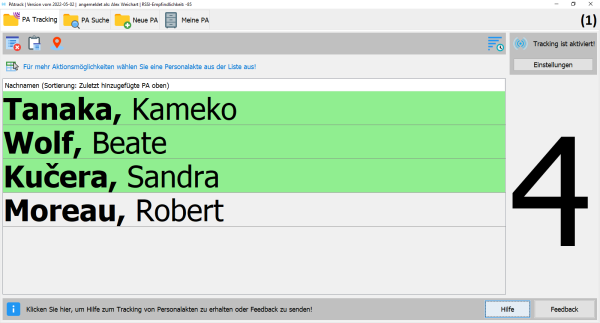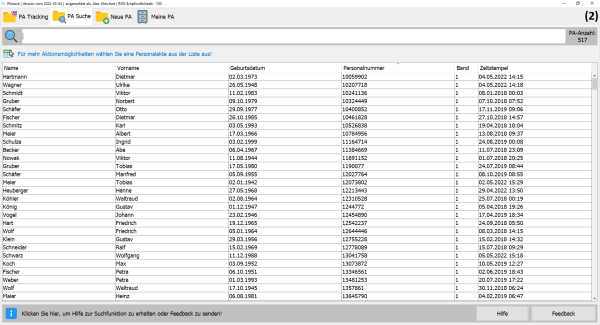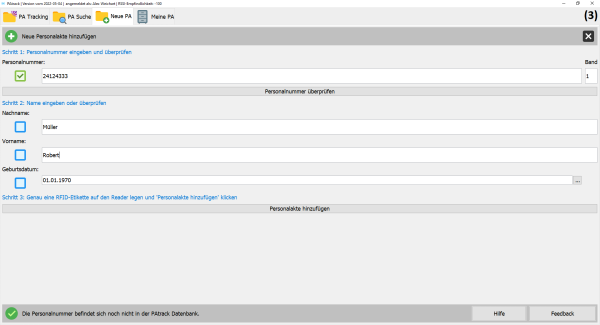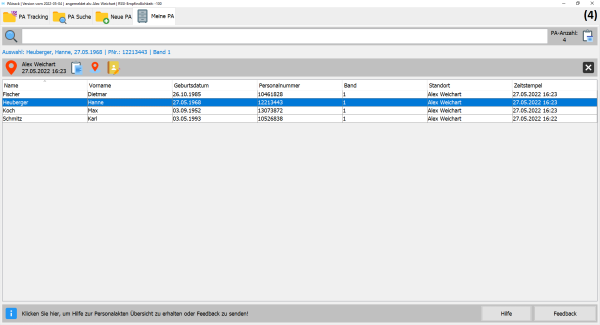Project: PAtrack - Tracking physical personnel files in HR

PAtrack is a system for digitally tracking the location of paper files at the HR department of the University of Regensburg.
Status: ongoing
Runtime: 2018 -
Participants: Raphael Wimmer, Alexander Weichart, Clara Hilmer, Marie Sautmann
Keywords: physical files, file tracking
Background
The HR department at the University of Regensburg manages more than 5,000 paper files of university employees. While there are plans and pilot projects for a state-wide conversion to an electronic file management system, it is not clear when this will actually happen. Thus, for the foreseeable future, the employees in the HR department will have to work with the paper files. A major limitation of paper files is that they can only be in one place at a time, and thus one needs physical access to a file to work with it. Finding a file can be very time-consuming, however. If the required personnel file is not currently stored in the personnel registry, there is no easy and quick method to locate that file. Tracking down such files is extensive and causes delays in the whole process. Whenever an HR employee was unable to find the paper file in the personnel registry, they would send an email to all colleagues, asking them to please return the file to the registry as soon as possible. In some cases, files went missing permanently, requiring the HR department to reconstruct them from date in other systems and previous correspondence.
Goals
The university's HR department asked us to develop a digital tracking system for paper files. The main tasks of the system are:recording the most recent location of each file andproviding an efficient user interface for retrieving the location. By reducing the need to painstakingly search for the physical file, PAtrack aims to make working with paper files more efficient, effective, and satisfying. A major goal was to keep the required overhead as low as possible so that each employee in the HR department would see a benefit from using the system.
Method
An initial requirement analysis was conducted by Jonas Massinger in his Master's thesis [1]. Following the User-Centered Design approach, he initially recorded and visualized the typical path of a personnel file by shadowing HR employees. The requirements engineering process was completed by conducting interviews and an online survey. He then created a model for basic processes of three groups of people in HR – clerks, heads of division and staff members of the personnel registry – to identify possible tracking points. The final user requirements were compiled into user stories.
A comparison and evaluation of different possible tracking systems led to the decision to use radiofrequency identification (RFID). With RFID, no line of sight is needed between paper file and reading device. By embedding the RFID-reading device into the users' desks, the users don't need to explicitly scan a file. Instead, each file placed on the desk gets scanned automatically. Thus, the system can easily be integrated into existing workflows. Furthermore, tracking of multiple files at the same time is possible (stack/bulk reading).
Jonas Massinger implemented a first version of the tracking system PAtrack using RFID technology as a proof of concept. A client written in Java connects to the reading device, provides a graphical user interface, and stores location information in a central database on the network. The graphical user interface was created through an iterative optimization process that included regular stakeholder meetings, Guerilla tests of PAtrack functions, and a field study test rollout of the system in a real working environment.
Status
After the test rollout, the project went into the next phase. A project budget to purchase necessary hardware got approved, and administrative IT set up a database in the university network to store the locations of real personnel files.
In Autumn 2021, another series of interviews to assess additional or changed requirements (e.g. due to Covid-19 pandemic), was conducted. After implementing revisions, we started a pilot phase in an HR unit in Spring 2022.
Hardware
We use the Nordic ID Stix, a credit card sized UHF RFID reader with USB connectivity, to track passive RFID labels following the ISO18000-6C standard.
Software
The graphical user interface consists of four tabs: tracking personnel files (“PA Tracking”), searching for personnel files (“PA Suche”), creating a new personnel file (“Neue PA”), overview of the personnel files in my office (“PA Übersicht”). PAtrack is developed in Java, PostgreSQL is used as database.
(1) Tracking Tab
This tab manages the tracking process, displaying all relevant activities of the RFID reader to the user. Freshly tracked files are listed, and their total number is displayed. Clicking a file in the list displays more information.
(2) Search Tab
This tab functions as an overview over all personnel files. Via a search bar, files can be filtered. Clicking files in the list displays more information.
(3) File Creating Tab
To use PAtrack, all personnel files need to be equipped with an RFID transponder and the related personal data must be inserted into the database. The “New File” tab guides users through this process of creating a new file.
(4) Overview Tab
In this tab, the users can see an overview of the personnel files at their location.
Results
A report on the project will be published after evaluation of the full rollout.
Limitations
Due to regulatory restrictions, the tracking system cannot be integrated into existing personnel management programs. As a result, a standalone software is necessary.
Limitations may exist on the side of the users. Since consistent usage is required for the system to track all personnel files reliably, users that use the system inconsistently will not have their files updated as often as others. This may lead to discrepancies in the information available to the system. The current system may also fail to represent some files correctly due to the reliance on manual input from users in the file creation process.
References
[1] Jonas Massinger (2018). Entwicklung und Evaluation eines Systems zum Tracking von Papierakten in der Abteilung für Personalangelegenheiten an der Universität Regensburg. Master's thesis, University Regensburg.
Publications
News
Visit by Minister-President Dr. Markus Söder (2022-05-05)
We presented current and upcoming research. (more...)



